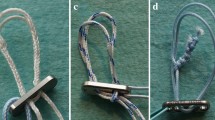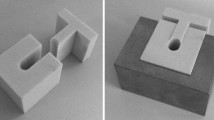Abstract
Elongation and migration of ACL grafts will lead to a deterioration of the initial stability of ACL reconstructions. The graft migration has been sparsely investigated independently from the elongation of the graft–fixation complex. The hypothesis of this investigation was that cyclic tensile loads cause a measurable migration of the grafts. Three graft/fixation combinations were investigated in human femora (n = 7): human bone-patellar tendon grafts fixed with a biointerference screw (BPTG-IS) and free tendon grafts (porcine) fixed with either a Bio-TransFix pin (FTG-TF) or an Endobutton CL (FTG-EB). The grafts were fitted with tantalum markers. Then, the specimens were repetitively loaded (50–250 N, 800 cycles). The marker position was fluoroscopically determined at defined intervals and the migration calculated from the change in position relative to a fiducial marker within the bone. A migration of the grafts occurred in all three groups. The migration in the FTG-EB group was significantly larger than in the two other groups (P < 0.01). After 800 cycles, average migration was 0.3 (±0.2) mm in the BPTG-IS group, 0.7 (±0.4) mm FTG-TF group, 2.0 (±1.3) mm in the FTG-EB group. This migration might contribute to a loss of initial stability. Because the graft migration was dependent on the technique, the presented data might provide additional arguments for making the decision on the most appropriate graft/fixation combination.




Similar content being viewed by others
References
Adam F, Pape D, Schiel K, Steimer O, Kohn D, Rupp S (2004) Biomechanical properties of patellar and hamstring graft tibial fixation techniques in anterior cruciate ligament reconstruction: experimental study with roentgen stereometric analysis. Am J Sports Med 32:71–78
Ahmad CS, Gardner TR, Groh M, Arnouk J, Levine WN (2004) Mechanical properties of soft tissue femoral fixation devices for anterior cruciate ligament reconstruction. Am J Sports Med 32:635–640
Aït Si Selmi T, Fithian D, Neyret P (2006) The evolution of osteoarthritis in 103 patients with ACL reconstruction at 17 years follow-up. Knee 13:353–358
Au AG, Raso VJ, Liggins AB, Otto DD, Amirfazli A (2005) A three-dimensional finite element stress analysis for tunnel placement and buttons in anterior cruciate ligament reconstructions. J Biomech 38:827–832
Becker R, Voigt D, Stärke C, Heymann M, Wilson GA, Nebelung W (2001) Biomechanical properties of quadruple tendon and patellar tendon femoral fixation techniques. Knee Surg Sports Traumatol Arthrosc 9:337–342
Brown CH, Wilson DR, Hecker AT, Ferragamo M (2004) Graft-bone motion and tensile properties of hamstring and patellar tendon anterior cruciate ligament femoral graft fixation under cyclic loading. Arthroscopy 20:922–935
Ciccone WJ, Bratton DR, Weinstein DM, Elias JJ (2006) Viscoelasticity and temperature variations decrease tension and stiffness of hamstring tendon grafts following anterior cruciate ligament reconstruction. J Bone Jt Surg Am 88:1071–1078
Eriksson K, Anderberg P, Hamberg P, Olerud P, Wredmark T (2001) There are differences in early morbidity after ACL reconstruction when comparing patellar tendon and semitendinosus tendon graft. A prospective randomized study of 107 patients. Scand J Med Sci Sports 11:170–177
Hart AJ, Buscombe J, Malone A, Dowd GSE (2005) Assessment of osteoarthritis after reconstruction of the anterior cruciate ligament: a study using single-photon emission computed tomography at ten years. J Bone Jt Surg Br 87:1483–1487
Hertel P, Behrend H, Cierpinski T, Musahl V, Widjaja G (2005) ACL reconstruction using bone-patellar tendon-bone press-fit fixation: 10-year clinical results. Knee Surg Sports Traumatol Arthrosc 13:248–255
Kartus J, Movin T, Karlsson J (2001) Donor-site morbidity and anterior knee problems after anterior cruciate ligament reconstruction using autografts. Arthroscopy 17:971–980
Khan R, Konyves A, Rama KRBS, Thomas R, Amis AA (2006) RSA can measure ACL graft stretching and migration: development of a new method. Clin Orthop Relat Res 448:139–145
Kousa P, Järvinen TLN, Vihavainen M, Kannus P, Järvinen M (2003) The fixation strength of six hamstring tendon graft fixation devices in anterior cruciate ligament reconstruction. Part II: tibial site. Am J Sports Med 31:182–188
Lidén M, Ejerhed L, Sernert N, Laxdal G, Kartus J (2007) Patellar tendon or semitendinosus tendon autografts for anterior cruciate ligament reconstruction: a prospective, randomized study with a 7-Year follow-up. Am J Sports Med 35:740–748
Loh JC, Fukuda Y, Tsuda E, Steadman RJ, Fu FH, Woo SLY (2003) Knee stability, graft function following anterior cruciate ligament reconstruction: Comparison between 11 o’clock, 10 o’clock femoral tunnel placement. 2002 Richard O’Connor Award paper. Arthroscopy 19:297–304
Majewski M, Susanne H, Klaus S (2006) Epidemiology of athletic knee injuries: a 10-year study. Knee 13:184–188
Mastrokalos DS, Springer J, Siebold R, Paessler HH (2005) Donor site morbidity and return to the preinjury activity level after anterior cruciate ligament reconstruction using ipsilateral and contralateral patellar tendon autograft: a retrospective, nonrandomized study. Am J Sports Med 33:85–93
Milano G, Mulas PD, Ziranu F, Piras S, Manunta A, Fabbriciani C (2006) Comparison between different femoral fixation devices for ACL reconstruction with doubled hamstring tendon graft: a biomechanical analysis. Arthroscopy 22:660–668
Mithoefer K, Gill TJ, Vrahas MS (2005) Supracondylar femoral fracture after arthroscopic reconstruction of the anterior cruciate ligament. A case report. J Bone Jt Surg Am 87:1591–1596
Nurmi JT, Sievänen H, Kannus P, Järvinen M, Järvinen TLN (2004) Porcine tibia is a poor substitute for human cadaver tibia for evaluating interference screw fixation. Am J Sports Med 32:765–771
Pedowitz RA, Popejoy DJ (2004) Initial laxity does not correlate with subsequent laxity after ACL reconstruction in humans: a prospective evaluation. Am J Orthop 33:560–564
Riemersa DJ, Schamhardt HC (1982) The cryo-jaw, a clamp designed for in vitro rheology studies of horse digital flexor tendons. J Biomech 15:619–620
Roos PJ, Hull ML, Howell SM (2004) How cyclic loading affects the migration of radio-opaque markers attached to tendon grafts using a new method: a study using roentgen stereophotogrammetric analysis (RSA). J Biomech Eng 126:62–69
Shelburne KB, Torry MR, Pandy MG (2005) Muscle, ligament, and joint-contact forces at the knee during walking. Med Sci Sports Exerc 37:1948–1956
Smith CK, Hull ML, Howell SM (2005) Migration of radio-opaque markers injected into tendon grafts: a study using roentgen stereophotogrammetric analysis (RSA). J Biomech Eng 127:887–890
To JT, Howell SM, Hull ML (1999) Contributions of femoral fixation methods to the stiffness of anterior cruciate ligament replacements at implantation. Arthroscopy 15:379–387
Weiler A, Peine R, Pashmineh-Azar A, Abel C, Südkamp NP, Hoffmann RFG (2002) Tendon healing in a bone tunnel. Part I: biomechanical results after biodegradable interference fit fixation in a model of anterior cruciate ligament reconstruction in sheep. Arthroscopy 18:113–123
Yamaguchi S, Sasho T, Tsuchiya A, Wada Y, Moriya H (2006) Long term results of anterior cruciate ligament reconstruction with iliotibial tract: 6-, 13-, and 24-year longitudinal follow-up. Knee Surg Sports Traumatol Arthrosc 14:1094–1100
Zantop T, Weimann A, Wolle K, Musahl V, Langer M, Petersen W (2007) Initial and 6 weeks postoperative structural properties of soft tissue anterior cruciate ligament reconstructions with cross-pin or interference screw fixation: an in vivo study in sheep. Arthroscopy 23:14–20
Author information
Authors and Affiliations
Corresponding author
Rights and permissions
About this article
Cite this article
Staerke, C., Möhwald, A., Gröbel, KH. et al. ACL graft migration under cyclic loading. Knee Surg Sports Traumatol Arthrosc 18, 1065–1070 (2010). https://doi.org/10.1007/s00167-009-0970-2
Received:
Accepted:
Published:
Issue Date:
DOI: https://doi.org/10.1007/s00167-009-0970-2




